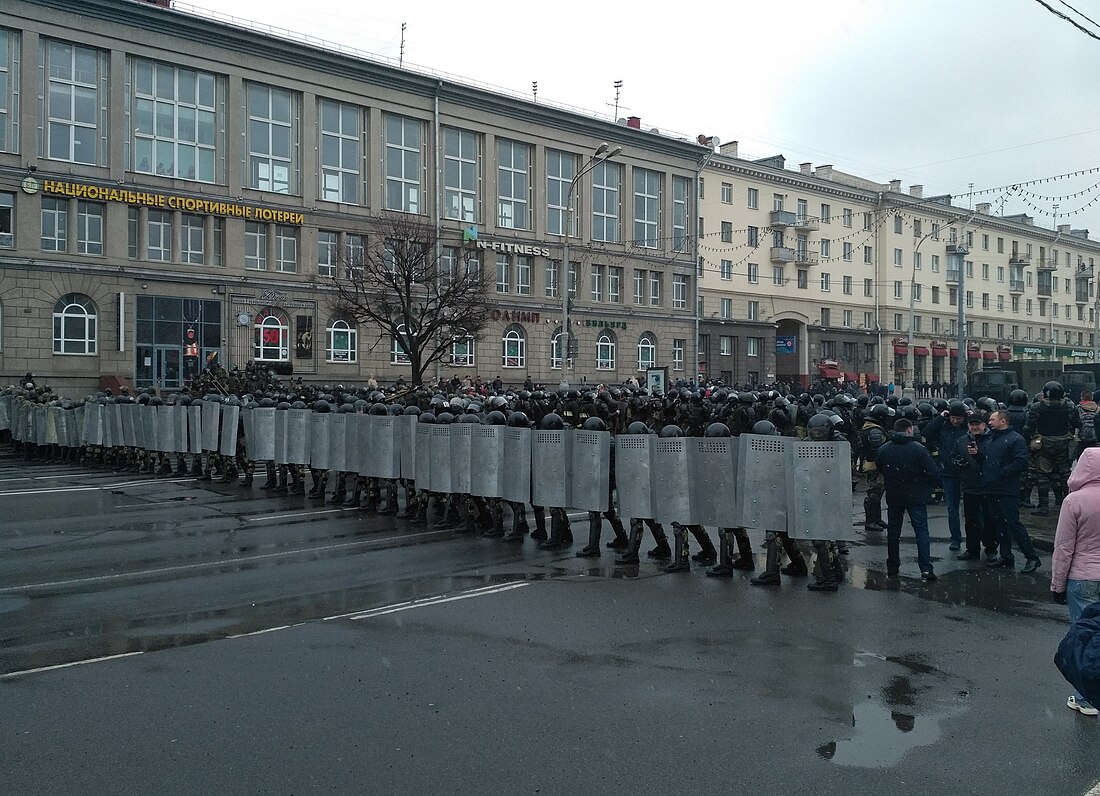Top Qs
Timeline
Chat
Perspective
2017 Belarusian protests
Series of political demonstrations From Wikipedia, the free encyclopedia
Remove ads
The 2017 Belarusian protests were a series of demonstrations and street protests against President Alexander Lukashenko that broke out in late February 2017. Protesters mobilized against a tax levied against the unemployed in Belarus. Demonstrations and marches were held in sites throughout the country with sizes of several hundred to several thousand gathering at a given time.
You can help expand this article with text translated from the corresponding article in Belarusian. (May 2017) Click [show] for important translation instructions.
|
Remove ads
Context
Belarus has been described for several years as Europe's "last dictatorship" [by whom?] with no genuine political opposition against Lukashenko possible.[4] Previous protests in 2011 and 2015 resulted in mass arrests. The country has also been in an economic recession since 2015 due to falling gasoline prices and that year a law was passed taxing the unemployed.[1] Roughly 470,000 Belarusians are obliged to pay the tax but only about 10% have since it was issued.[1]
Remove ads
Activities
Approximately 2,500 protesters[5] filled the streets in Minsk on 17 February to protest a policy that required anyone who works for less than 183 days[6] per year to pay US$250 for "lost taxes" to help fund welfare policies.[7] This converts to approximately 5 million Belarusian rubles.[1] The law has proven unpopular and has been mocked in the public as the "law against social parasites".[1] On 19 February, another 2,000 demonstrated in the second city of Gomel.[7] Both gatherings were unauthorized but were not disrupted by authorities. Smaller demonstrations were held in other cities.[8]
On 25 March, opposition leader Vladimir Nekliayev, who was set to speak at the main protest, was stopped in the morning on his way to Minsk, his wife said.[9]
The government defended the mass arrests and beatings against citizens by alleging that the police had found "petrol bombs and arms-laden cars" near a protest in Minsk.[10]
Remove ads
Timeline of the events
Summarize
Perspective
19 February
26 February
- Brest – a rally, about 300 participants.
- Baranovichi – a rally, about 300 participants.
- Babruysk – gathered about 1,500 protesters.[15]
5 March
The mayor of Brest met with the protesters.
10 March
- Maladzyechna – a rally in the Central Square, speeches, the adoption of a resolution and the procession to the tax service. The number of people gathered from 500 to 1,000 people.
After the rally, the organizers received 15 days of arrest.[17]
11 March
12 March
- Brest – on the square came out 200 people [19]
- Babruysk – about 700 protesters gathered at Pieramohi square. The rally was spontaneous, none of the opposition leaders were present.[20][21][22]
- Orsha - the number of people gathered exceeded 1,000 people. Before the rally, journalists were detained to check documents [23]
- Rahachow - about 400 participants. People discussed the current government and whether there is an alternative to it, and complained about the lack of work.[24]
15 March
To the protesting crowd came member of parliament Igor Marzalyuk, five people arrested [26]
- Minsk – From the cinema "Kastryčnik" to Banhalor Square and Družby Narodaŭ Park passed 1.5 to 4.5 thousand people, chanting "Long Live Belarus!", "No to Decree No.3 – Lukashenka go away!"[25]
About 40 people were detained in Minsk.[27]
25 March

1 May
- Minsk – 400 people came to a banned protest despite the jailing of Mikola Statkevich, opposition leader and main organizer of the event.[32]
Remove ads
See also
References
Wikiwand - on
Seamless Wikipedia browsing. On steroids.
Remove ads

